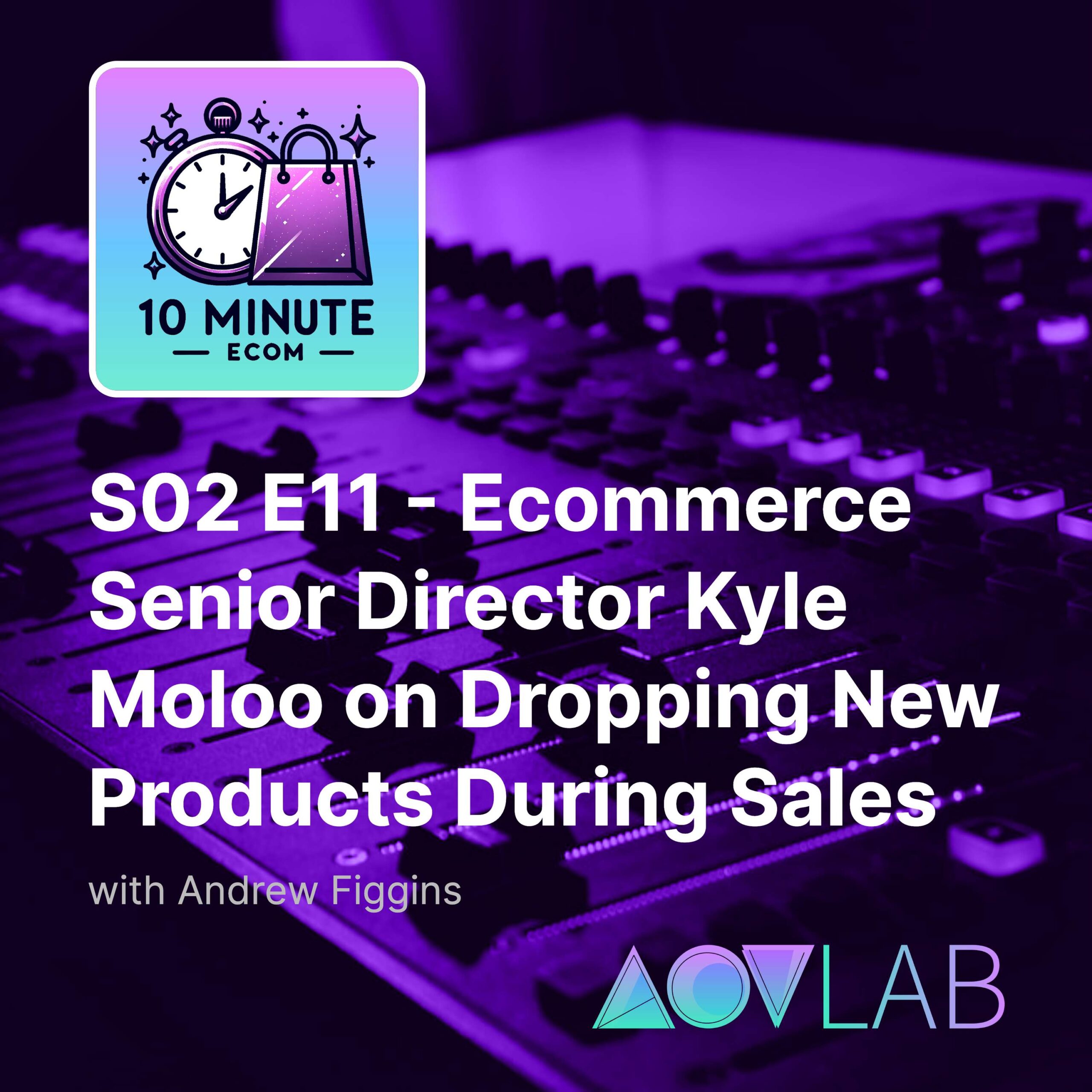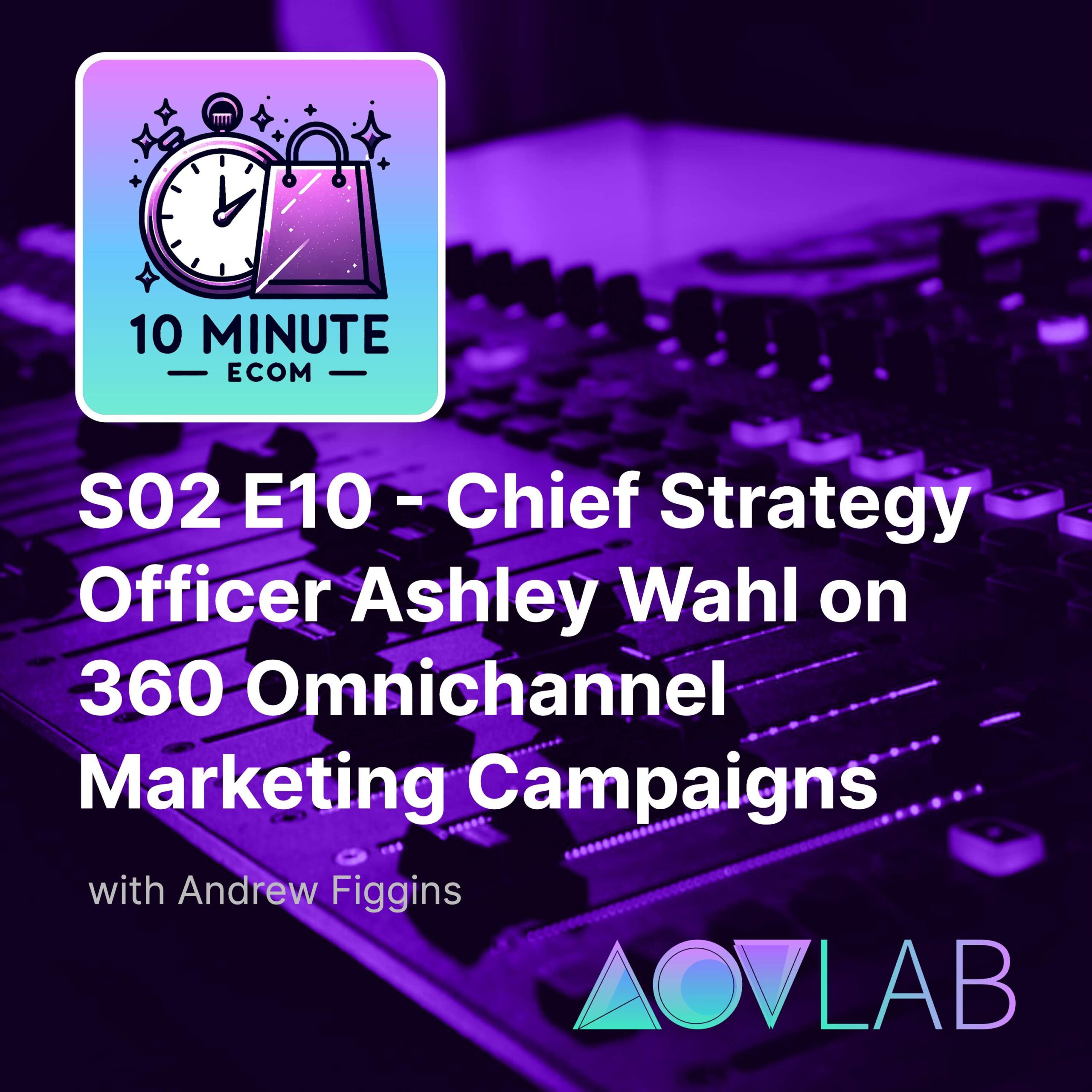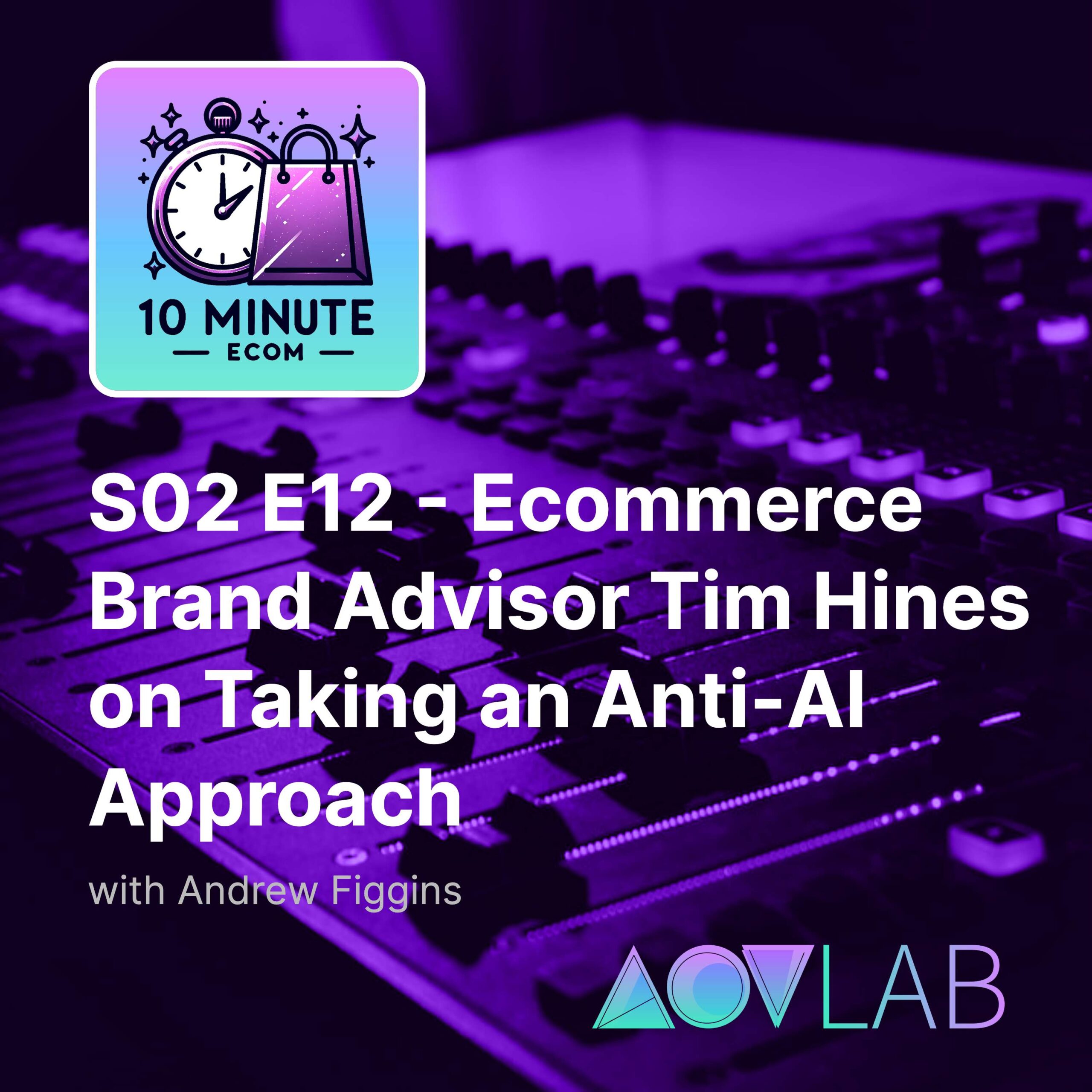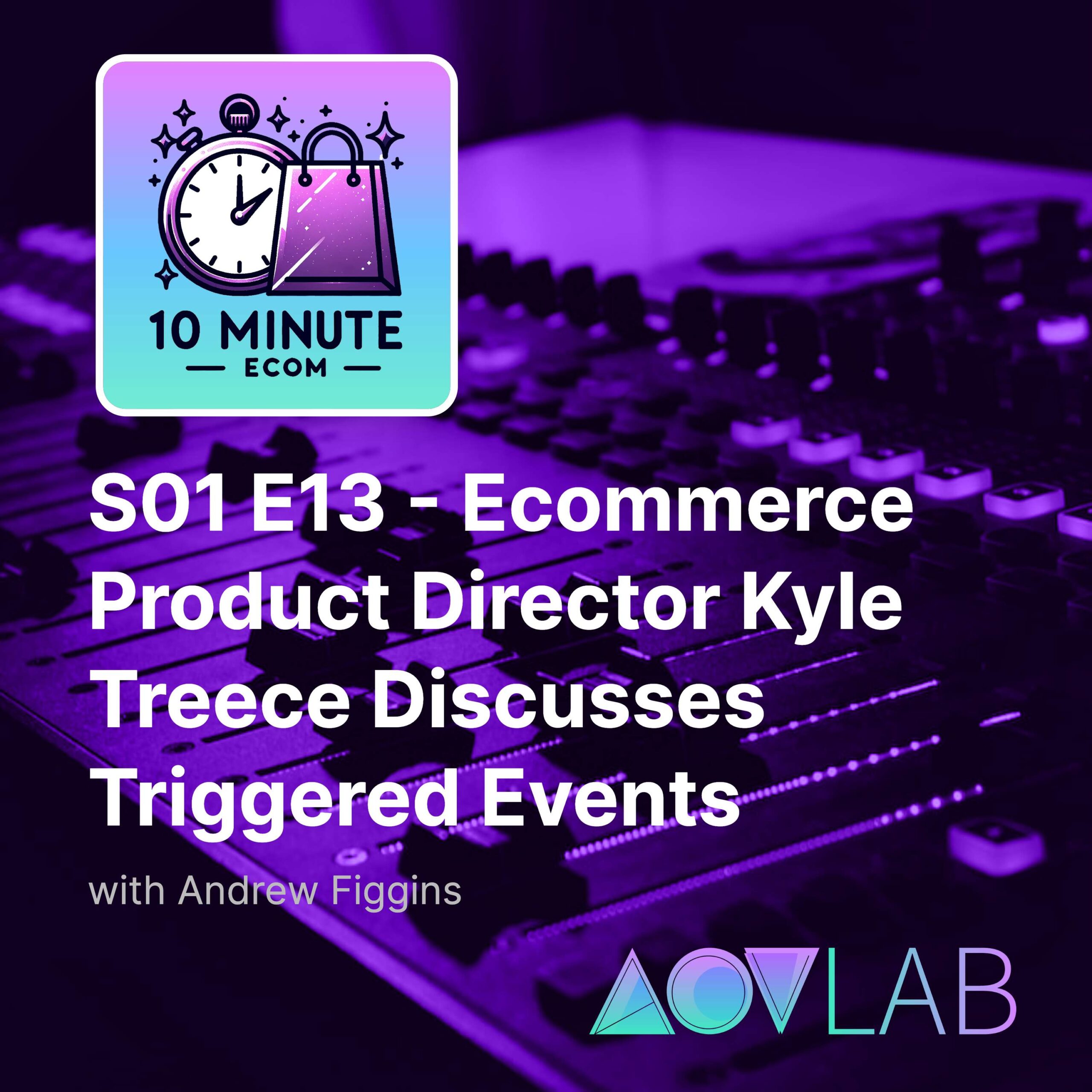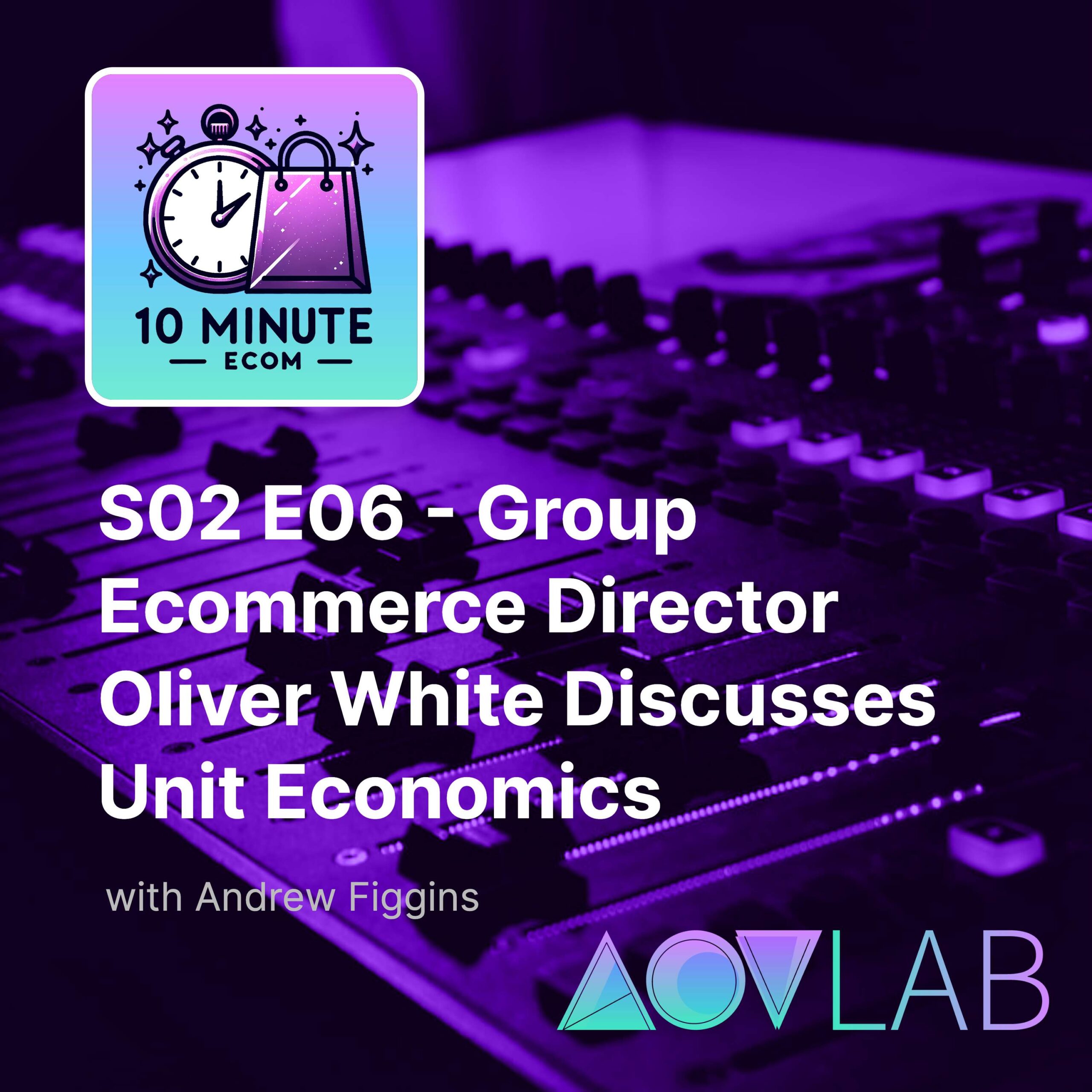View Full Transcript
Episode Transcript
[00:00:07] Speaker A: Hello, ecommerce fans, and welcome to ten minute Ecom and AOV Lab podcast. Every episode we break down a new and different tactic that can help you improve your ecommerce KPIs key performance indicators I'm your host, Andrew Figgins. I am an ecommerce professional. You may know me as the founder of AOV Lab, the former vp of product innovation at Scrubs and beyond, or is the former director of ecommerce technology at Rural King.
Today I'm excited to be talking to Kyle Malou, an e commerce colleague doing very interesting work in e commerce. And without further ado, Kyle, what did.
[00:00:43] Speaker B: You come on the show to share.
[00:00:44] Speaker A: Today with your ecommerce colleagues?
[00:00:46] Speaker C: Hi, I'm Kyle from Sunday Swagger, based out of Yorba Linda, California. The one thing that I've seen that works in ECom is dropping new products during sale periods.
[00:00:56] Speaker B: Thank you, Kyle.
[00:00:57] Speaker A: After the ad, we'll get right into the chat. Today's episode of ten minute Ecom is brought to you by shop AOV Lab. It is a brand new store with fun apparel and gear specifically for ecom professionals just like you and me. We've got high quality embroidered and printed t shirts, hoodies, and hats that will spice up any Zoom call or in person meeting with your team. If you lead a team, these products make for awesome gifts to celebrate hitting a conversion rate or average order value milestone. If you work in ecommerce, I think you'll not only find some humor in these products, but also a sense of pride for what you do every day. Again, the site is shop aov lablab.com. Head over right now and browse while you listen. Unless you're driving. In that case, pull over. You've got to see and share these products one last time. The website is shop aov lablab.com.
And now back to the show.
[00:02:00] Speaker B: Excellent, Kyle. I'm so excited to talk to you today here on ten minute ecom. Thanks for stopping by the show. We were chatting about this before the recording started today, and I was getting excited, just like I've got to turn on the audio recorder here so we can get this down on the recording.
[00:02:18] Speaker C: But we were talking about how to.
[00:02:21] Speaker B: Really handle those high sale periods, and you had some really interesting ideas about an approach to that. You shared a strategy that would essentially allow you to continue to increase aov at a time of year that it's really hard to do in most cases.
[00:02:38] Speaker C: Yeah, absolutely. During Black Friday or any high sale periods, you're going to be thrown out a lot of discounts. You're going to see a lot of competition. So you're looking at ways to differentiate and capture people's sales while at the same time building on those KPIs that we're always tracking in ECOM. Right. So how do I improve aob? How do I improve conversion rate? How do I improve repeat purchase rate? And overall, the goal is get to a higher LTV. So one thing we were doing, and we rely, like a lot of brands do, probably on a lot of meta ads and Instagram ads for Black Friday. So when it came to net new customer acquisition, we also knew that these customers coming in tend to be the worst type of customer that you're going to get. They're hunting for a sale, they're going to be new to brand and they don't necessarily have a reason to come back and buy again. So rather than trying to be really profitable on the first purchase, which maybe a lot of brands might try to do, we tried to get them in the door and just break even on that first purchase, but really get them back to make not only another purchase during that Black Friday sale period, but hopefully another purchase after as well.
[00:03:52] Speaker B: You had a pretty interesting approach to going about it in that you were combining the sale time of year with. It sounded like some new products that you were introducing at the same time.
[00:04:02] Speaker C: Yeah, exactly. So we ran our Black Friday, or call it cyber week cyber month sale for about two and a half weeks. Some of the greatest Ecom tactics during sale periods of any time and during this time is always early access and then to extend a day later afterwards. So we definitely employed those tactics. Early access, which was a mobile app exclusive. We use tap cart for our mobile app and absolutely love it. They make it pretty straightforward and simple to employ those tactics. So with early access, we actually dropped three new products at the very beginning of Black Friday. So that got people really excited. When you throw in three new products in addition to your sale items, we were able to build AOB on that first purchase. Going past that for the rest of the sale, which went on another 15 or 16 days, we would drop another ten new products almost every other day. So the goal in that being was that we would increase our repeat rate, get those new customers to come back and buy again. And a way to do that also nobody wants to pay for shipping is by offering free shipping exclusively through our mobile app as well. How's that strategy?
[00:05:16] Speaker B: Excellent. Did you have a goal in mind? And maybe not so much as you were thinking about the customer acquisition strategy there, but I know some companies have roas goals or a goal in terms of CAC versus LTV, what's your sort of lighthouse metric in terms of all those possibilities?
[00:05:36] Speaker C: Absolutely. So we have goals for each one of those metrics, and during sales periods those obviously adjust. We knew that on Facebook introducing new ads were going to lead to very high CPM, so our cost to inquire was going to be pretty high. And it was. So we weren't surprised by that. So we knew we needed our LTV on these customers, let's say over the next six months to be three x our CAC. During that period, our goal for Facebook and Instagram Roas was about two and a half and our MeR goal was about five. Knowing that these sale periods are more of a retention play typically than new customer acquisition. Not to say we weren't spending a bunch on meta, but we knew we needed to get a lot out of our email list, out of our SMS list, and out of our push subscribers through our mobile app as well.
[00:06:26] Speaker B: It's good that you had the three different channels there. I know in my past working in ecommerce, it seemed to me like we were really hammering that email channel over Black Friday period, over holiday period, and sending maybe even multiple emails per day, which always seemed like a lot. It worked in some cases, but like you said, the customers that were coming through that didn't tend to be the highest value customers for us. Did you have an approach for ushering those customers through not only that holiday time, but even after in your approach to communicating with them?
[00:07:04] Speaker C: Yeah, absolutely. Our existing customer list and we decided to roll up our sleeves and build out a really big segment. You almost go back to anyone who's ever purchased and hit them. During Black Friday early access, you sent out a couple of emails every day we were sending out an email and on actual Black Friday and Cyber Monday, multiple emails for sure. Anyone who was new to brand that we acquired through ads. Absolutely. So we wrote out a plan before Black Friday even started saying these are going to be low LTV initially, potentially low aov as well, and always hunting a discount. So we knew that our January and our December and January content calendars needed to include campaigns, both email and sms, that would offer sale items bundles. Other ways that these people could see value in discounts because they tend to be more discount shoppers. And rather than just going for that kind of spray and pray method on email and sending everybody the same thing a few times a week, we did break out that cohort and I'm using triple whale to follow them very closely to see over three months, over six months, over a year. What is our LTV? What is our repeat purchase rate? Are we getting enough out of these guys because the cost to acquire on them was so much higher than our business's usual time, that ended up being really important.
[00:08:24] Speaker B: I'm curious, Kyle, in terms of LTV, this is a multi million dollar question. I think probably for both of us. What are some ways that you feel like have been most effective at increasing that LTV over time? And maybe not necessarily just for customers that come in over the holiday time, but just customers in general?
[00:08:47] Speaker C: Yeah, there's so many ways. On the retention side, you have so many tactics you can use. Something we've employed and a lot of brands use is a rewards and loyalty program to build on that LTV. I do think there's some kind of exhaustion in the industry of points programs. So being very creative and getting out of the typical three tier points program and even exploring something like memberships, there are tools out there that are great to do that, making it easier on the customer to understand any offers as well. In ecom, we're always seeing some type of sale, but what I like to do is not discount the entire product library or a whole site with the site wide doing quicker flash sales also. So maybe in just channel specific. So maybe it's just through sms or just through the mobile app. Buy three of these and save ten or 15%. Buy one, get 150 percent off for 24 hours only. Drive some urgency to the cohort that was hunting those deals, but then to your highest LTV customers, something like a membership program. So maybe for whatever the buy in you want to charge on that membership fee, they're always getting 20% cash back, maybe on every order. Free shipping, potentially a heightened level of customer service as well. There's so many things you can do to provide value as a d to c operator, and you need to pull in those levers if you want to build LTV for your customer.
[00:10:10] Speaker B: Do you see the mobile app customers, their customer behavior being very different from the customers that are maybe on their mobile devices, just on the website?
[00:10:21] Speaker C: Yeah, absolutely. We're tracking that and looking at it closely, not just monthly, I'd say weekly. We do have about a 20% higher aov and like a 20% higher conversion rate on our mobile app customers, especially those that are opted into push notifications as well. That Black Friday strategy of offering free shipping in the mobile app and early access through the mobile app helped us grow our subscriber list for push notifications another 25%. So coming out of that now, those are the ones who jump the fastest when we have new drops, when we have certain offers.
[00:10:55] Speaker B: So, yeah, absolutely, Kyle, I like that what you're presenting today with this topic and these tactics applies not only to Black Friday and the holiday time, but depending on the business. I know in the Scrubs business that I was in most recently, there was like a time in May that was basically a holiday time. It was called nurses Week. And I wish we had talked a year ago because I think I would have been more prepared for nurses week last year. But hey, it is ten minute ecom. It's a brief show. We don't have a whole lot of time. I wanted to ask you, before we head off today, is there anything else that you'd like to share with your ecommerce colleagues and peers out there?
[00:11:35] Speaker C: I appreciate you having me on. It's always great to chat. I love chatting with Ecom, with professionals. There's so many different approaches and ways to go about doing what we do. I would say when you don't want to be a brand that necessarily discounts all the time and you want to hold on to your brand equity, but ultimately, I think the brands that succeed are really the ones that not only create a great product, but really put their customer first and mean it instead of just trying to do whatever they can for that next sale. And over time, I think the goal really should be for all brands to be able to lead on retention and organic more than they do on advertising. But when you're in your beginning, like we are here in the first three years, you lean so much more on advertising to build that customer list. And employing some of these LTV tactics that I've talked about today or that are out there will help do that 100%.
[00:12:22] Speaker B: Hey, this is a knowledge sharing podcast and I really appreciate you coming on the show so that Kyle and sharing your knowledge with all of our ecommerce peers out there. Thank you.
[00:12:31] Speaker C: My pleasure. Thanks, Andrew.
[00:12:33] Speaker B: Samantha, we have hit that ten minute.
[00:12:37] Speaker A: Mark times two, so that's a wrap for today's episode. I want to again thank our guest, Kyle Malou. If you have a moment, be sure.
[00:12:44] Speaker B: To subscribe or follow the show on.
[00:12:46] Speaker A: Apple Podcasts, Spotify, Amazon Music, Google Podcasts, or wherever it is that you listen.
As mentioned earlier in the episode, please head on over to shop AOv Lablab.com, our brand new store that helps to support this podcast. It is launching with nearly 100 products, so plenty to choose from. Our top seller so far is a shirt that simply says ECom on it. I wear it around my extended family so I can point to it when my relatives ask me what I do.
I hope you enjoyed this episode of the show. Until next time, this is Andrew Figgins signing off and saying have a good one.
